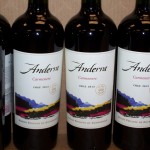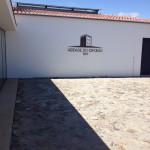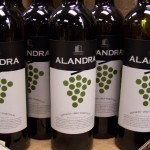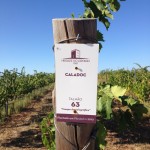In a weeks time, I taste a boatload of wine (seriously). I lot of my friends think that I’m lucky. Well, they’re right, and I wouldn’t give this job up for the world. The only thing that makes my job hard, is my feeling of responsibility to taste the samples given to me as quickly as possible and to put my reviews either in my Moleskine, on my Youtube channel (Stan The Wine Man TV), or right here on Stanthewineman.com. Here for your reading pleasure, are thirteen wines that I have reviewed in my Moleskine (good or bad), this past week.
2012 Milestone Cabernet Sauvignon (California)… $12.
Aromas of cherries and grape juice with hits of red flowers and cigar box. Very grapey on the palate (go figure, it’s made from grapes), with underlying dark cherry notes. Nice flow across the palate with black currants joining the party on the mid-palate leading into a grippy finish. I was actually surprised by the tannins on the finish, because they weren’t there up front. This cab actually reminded me a lot of some Spanish Garnacha. (C+)
2012 PopCrush Red (California)… $11.
This wine smells exactly like a chunk of black licorice with a touch of black currants and root beer. Kind of jammy notes of currant notes start to finish. However, there is an interesting mineral element that keeps it out of the fruit-bomb category. The tannins have good structure and a touch of grip. I know a lot of people who will like this wine, and I have to say that I think it has good balance and some complexity, which makes it interesting. (B-)
2012 Anderra Carmenere (Chile)… $12.
This bottle has the name Baron Philippe De Rothschild printed on the front of the label. That is a name that many of us are familiar with when it comes to French wines. Many of these top producers have looked to Chile, understanding the value of the land and fruit. Carmenere is king in Chile and this version is proof as to why that is so.
Aromas of red leaf lettuce, green bell pepper, asparagus. red cherries and blackberries. Nice currant and cherry notes up front, that evolves into notes of forest floor and minerals with tobacco joining the party. Wilted rose petal notes hit on the mid-palate with just a touch of veggie coming through on the back-end. The finish is delicious with notes of bittersweet chocolate lingering. If you haven’t given Carmenere a try yet, this would be a good start. (A-)
2011 Esk Valley Red Blend Gimblett Gravels (Hawkes Bay, New Zealand)… $21.
This baby has some old world action on the nose, with aromas of gravel, earth, dark cherries, currants, black raspberries and licorice. Crushed rock all day on the palate with a shovel load of dirt and a hit of iron (now that’s old world my friend). Red cherries and cranberries sneak into the picture front to back with a brightness that lingers. This is an old world style wine on an acid trip. A blend of 44% Merlot, 33% Cabernet Sauvignon and 23% Malbec. (C+)
2012 PopCrush White (California)… $11.
This baby has a lot of Viognier in it and it shows. Aromas of apricots, peaches, tangerine and cantaloupe. Notes of mandarin orange, tangerine and apricot come through on the front of the palate leading into a rounder mid-palate. The finish is dry with a load of citrus coming through. Notes of tangerine, lemon and mandarin with a slight hit of mango on the back-end. A blend of Viognier, Riesling, Gewurztraminer, Chardonnay and Moscato. I expected it to be a lot sweeter, and was pleasantly surprised by the drier finish. (B-)
2012 Milestone Chardonnay (California)… $12.
I got a little lemon scented soap on the nose with slight pear and oak notes coming through. Light pear notes come through on the palate with a creamy edge to it, then there is a big oak hit on the finish. The finish is awkward and not well-integrated, and the wine tastes just a touch fake, like it has some makeup on it. (D-)
2012 Anderra Sauvignon Blanc (Chile)… $12.
I really liked the nose on this puppy. Aromas of diesel, cut grass, melon and wet stone. Zesty on the palate with notes of kiwi and lime in spades. Grass notes hit on the mid-palate and leading into the mouth-watering, dry finish. This is a perfect match for shellfish of all kinds. (B)
2012 Avignonesi “Cantaloro” Red (Toscana, Italy)… $20.
Aromas of stewed meats, marinade, baking spices, black olives, green olives, tobacco, leather and wilted red flowers (seriously, I got that much out of it). Good structure and balance on this wine. Notes of currants and dark cherries up front with a healthy dose of tobacco, crushed rock and tar. There is a forest floor component that comes through on the mid-palate with a slight minty edge showing up. There is a brightness to this wine that is like the spine leading into a dark fruit meets crushed rock, meets dirt, meets leather, meets tar finish. This baby screams for grilled (or broiled) meats, or a serious red sauce with pasta. (A-)
2011 Tormaresca “Neprica” Red (Puglia, Italy)… $11.
A little stink action on the nose with notes of leather, tobacco, currants, black olives, wilted rose petal, blackberries and a hint of chocolate (two in a row). Black cherries, blackberries and tobacco notes up front on the palate and into the middle palate. Red flower notes come through on the backside with an interesting brightness. The finish features minerals, tobacco, cherry, red flowers and a trace of white pepper that lingers. 40% Negroamaro, 30% Primitivo and 30% Cabernet Sauvignon. (B+)
2012 Brooks Pinot Noir (Willamette Valley, Oregon)… $26.
Very aromatic on the nose with notes of cherries, black tea, root beer with a little cherry candy and Red Vine licorice on the back-end. Red flowers all day on the palate with a backdrop of cranberries and black tea. There is a fair amount of acidity on this wine with some blackberry leaf coming through on the finish and a hint of black tea. This is a baby that needs some time to flesh out. (B-)
2010 Array Cellars Chardonnay (Columbia Valley, Washington)… $22.
Aromas of dusty oak, ripe pineapple, butterscotch and apple. The oak is prominent on the palate with hits of baking spices and butterscotch with a touch of pineapple on the astringent finish. This chard is very awkward on the palate and very oaky. (C-/D)
2012 Tempus Cellars Riesling Evergreen Vineyards (Ancient Lakes, WA)… $16.
Pine notes come through on the nose joined by ripe lemons, saline and apples. Cutting acidity on the palate with a backdrop of ripe apples and peaches with a touch of apricots and ripe lemons. Minerals and orange blossoms come through on the long, bracing finish with a hint of rubber boot on the back-end. This is a classic example of how good Washington State Riesling can be (A-)
2012 Efeste “Feral” Sauvignon Blanc “Evergreen Vineyards” (Ancient Lakes, WA)… $21.
Aromas of pine needles, lemon, melon and a touch of sweaty arm-pit. Zesty, sharp and acidic on the palate with notes of under-ripe kiwi, lemon and lime. Very grassy and herbal on the mid-palate leading into a steely, lemon-lime driven finish. This is typical Efeste Sauvignon Blanc, wild and wooly. It needs a little time in the bottle to flesh out. (B+)
Cheers!
Stan The Wine Man





